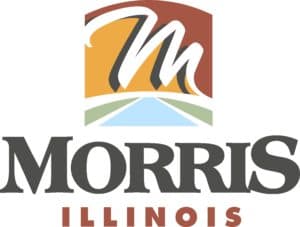In 1834, the very first log cabin was built in Morris...
In 1834, the very first log cabin was built in Morris at what is now Jefferson and Nettle Street. Eight years later, the Village of Morris was established. In 1839, villagers built the Shakey Bridge across Nettle Creek to influence stagecoach lines to travel through the village. By 1845, daily mail was being delivered by the United States Postal Service. With the opening of the I&M Canal in 1848, and the first steam train railroad in 1853, Morris continued to grow and prosper. Click on the links below for more information on the History of Morris.
EARLY HISTORY
In 1673, Canadian fur trader, Louis Joliet, and Jesuit missionary, Father Jacque Marquette, passed through the Illinois River Valley. It was Joliet who had a vision for a canal from the Illinois River to Lake Michigan that would connect the Atlantic with the Mississippi River. One hundred sixty-three years later his dream became a reality when construction began on the I&M Canal.
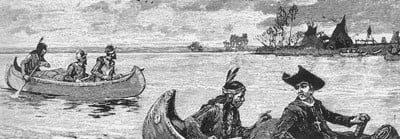
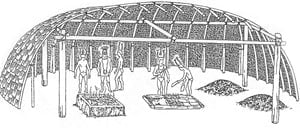
The first map of this area drawn by French fur trader Robert Cavalier Sieur de la Salle between 1679-1690 shows a village of 1,500 Mound Builders that were located near the present site of Morris. Nineteen of these mounds were found along Canal Street (now Illinois Avenue). The mounds were 2-4 feet hight and 17-30 feet in diameter at the base. Construction of the canal in the 1840’s uncovered several artifacts and skeletons. Over 10,000 similar mounds have been discovered throughout Illinois.
Believed to be over 300 years old, the oldest monument in Morris is the Red Cedar Pole that once stood in the center of a mound on Wauponsee Street, marking the grave of Illini Chief Nucquette. Worn away by time, the 30-ft height is now ten feet shorter and the carvings on its surface that told about the Chief’s life are gone. Since red cedar does not naturally grow in Illinois, its origin is a mystery.
The Illini (“Superior Men”) tribes were the first inhabitants that the French explorers encountered on the expedition across this area. The “ois” ending from the French language was added creating our state name – Illinois. Illini huts were made from tree bark or mats unlike the animal skin tipis (teepees) of the other tribes.

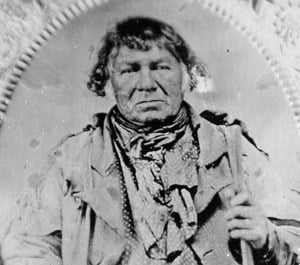
Chief to a tribe of Potawatomi by marriage, Shabbona (left) was nicknamed “a friend to the White Man” when he helped save the lives of settlers during the Black Hawk War of 1832. He lived in Grundy County until his death at age 84 and was buried at Evergreen Cemetery.
AGRICULTURE
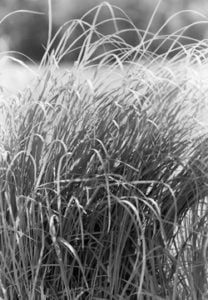 When agriculture was first attempted by the pioneers on the tough, heavy sod, it was thought that the prairie would never be good for farming. A “good” crop at that time yielded less than half the sown seed. It wasn’t until 1846 that John Deere’s Self-Scouring Plow, made of steel, not wood, was able to cut throught the grass and allowed agriculture to really take root in America’s heartland. Corn was introduced by the Native Americans, and soybeans came in 1890 from the Orient.
When agriculture was first attempted by the pioneers on the tough, heavy sod, it was thought that the prairie would never be good for farming. A “good” crop at that time yielded less than half the sown seed. It wasn’t until 1846 that John Deere’s Self-Scouring Plow, made of steel, not wood, was able to cut throught the grass and allowed agriculture to really take root in America’s heartland. Corn was introduced by the Native Americans, and soybeans came in 1890 from the Orient.
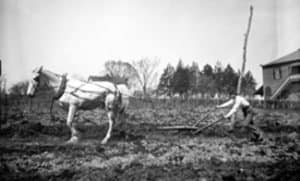 The Big Blue Stem variety of prairie grass grew as tall as 6-8 feet, hiding horses, cattle, and an occasional child. The last field of original prairie in Grundy County is located at Goose Lake Prairie State Park. Every three years, to simulate nature, the plants are burned to replace lost nitrogen and minerals in the soil. Early settlers were often confronted with wildfires set off by lightning.
The Big Blue Stem variety of prairie grass grew as tall as 6-8 feet, hiding horses, cattle, and an occasional child. The last field of original prairie in Grundy County is located at Goose Lake Prairie State Park. Every three years, to simulate nature, the plants are burned to replace lost nitrogen and minerals in the soil. Early settlers were often confronted with wildfires set off by lightning.
ARCHITECTURE
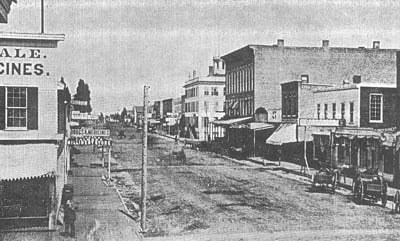
Architectural styles that appeared in Morris in the 1800’s were the Greek Revival (1840-60); upright-and-wing (1860-80); Victorian Italianate & Gothic (1880’s); and Queen Anne & Picturesque Eclectic (1890’s).
The oldest section of town, Court House Square, was established in 1843. There have been countless celebrations on the lawn as well as the first execution – a hanging – for a murder in 1890. Three court houses have been built there. The first was built in 1843 by Wm. Armstrong, founder of Grundy County. The first one, though, was so poorly constructed that another had to be built. It was completed in 1858.
The second court house, made of stone and topped with a dome (removed in 1904), was built by John Van Osdel – the architect who designed Chicago’s Palmer House. However, it was too small, so additions were made to the east and west in 1913. The outer walls of the Van Osdel structure became the inner walls of the third court house.
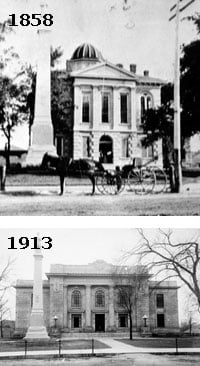

The first jail in 1846 was a 2-story log cabin with a square excavation in the ground. The prisoner was dropped into the hole and secured by an iron gate. It was declared unfit for humans, so in 1853 a brick one was built with proper cells. The stone jail (left) was erected in 1876 and then demolished in 1976 when additional courtrooms and a new jail were attached on the south end of the court house.
Lyman B. Ray built this home in 1869 on Vine Street. Ray helped organize the newly formed Republican Party for Grundy County and served in both houses in Springfield, until he eventually became Lt. Governor. William Stratton owned the house when he was the 32nd Governor of Illinois in 1953. The style of the house is Second Empire which was very popular in France. The identifying feature is the Mansard roof.

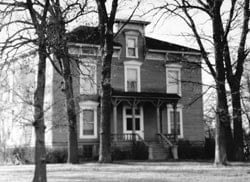
Edward Sanford, attorney & first principal of Center School, built this home on Vine Street in 1875. The architectural style is Victorian Italiante that was popular in the post-civil war era. It was constructed with eight marble fireplaces and a ballroom in the attic.
EDUCATION
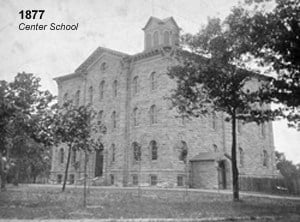
Mrs. Ann Nagle taught the first private school in her log cabin near the Depot in 1843. The first public school was the Old Center School in 1853 on the Northwest corner of Jackson and Franklin. Soon the building became too small and a “new” Center School (left) was built on Chapin Street in 1877 made of stone. But, the three stories was considered a fire hazard, so a brick building was built in 1923. This building remained an important learning center for many students until it was sold and demolished in 2003.
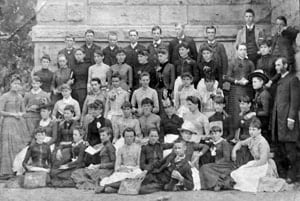
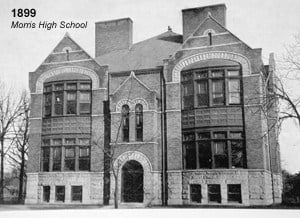
Morris High School was founded in 1870, and a building (right) was erected in 1899 on the Southwest corner of North and Franklin, with later additions in 1914. The high school’s first graduating class consisted of 3 students in 1873. It functioned at this location from 1899-1951 until a structure on Union Street was constructed for the new Morris Community High School. The old high school was remodeled into a grade school in 1955 and changed its name to Franklin School. It ceased as a school in 2001 and, then, became the Franklin Building & Galleria.
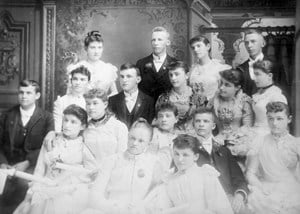
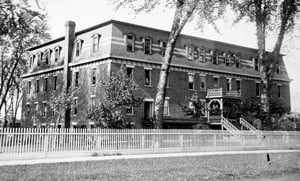
St. Angela’s Academy, on the east side of Morris, was founded by Mary McNellis in 1857 as a girl’s school. The land was donated by John McNellis, her father. The first two nuns came from Notre Dame, and at the height of its success, the school boarded 75 female students who were taught art, culture, faith, and refinement. The Academy lasted 100 years and was torn down in 1959 for a new subdivision.
FAMILY LIFE
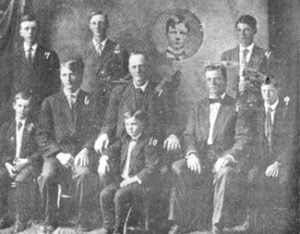
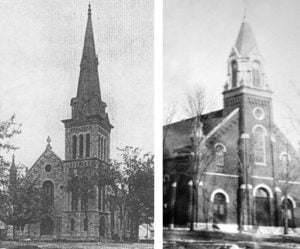 Family sizes were often quite large, but few were fortunate to have all children outlive their parents. One famous Morris family had nine sons; Arthur, Clifford, Eugene, Irving, Roy, Herbert, Maurice, Joyce, and Edward (pictured with their father, Knute Enger). They competed as their own baseball team in the early 1900’s until the unfortunate death of Edward who was electrocuted.
Family sizes were often quite large, but few were fortunate to have all children outlive their parents. One famous Morris family had nine sons; Arthur, Clifford, Eugene, Irving, Roy, Herbert, Maurice, Joyce, and Edward (pictured with their father, Knute Enger). They competed as their own baseball team in the early 1900’s until the unfortunate death of Edward who was electrocuted.
By the 1860’s, at least five denominations of the Christian faith were represented in Morris, all meeting within a few blocks of each other near the downtown – the Catholics, Baptists, Methodists, Episcopalians, and the Congregationalists. The Lutherns organized in 1880.
INDUSTRY
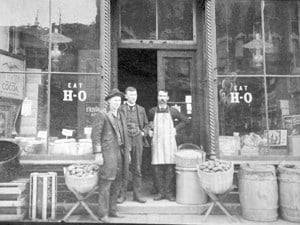 By 1877, Morris was a prosperous town. Business establishments consisted of 15 groceries, 6 dry goods, 5 grain merchants, 4 butchers, 10 blacksmiths, 6 cigar makers, and 20 saloons – to name a few.
By 1877, Morris was a prosperous town. Business establishments consisted of 15 groceries, 6 dry goods, 5 grain merchants, 4 butchers, 10 blacksmiths, 6 cigar makers, and 20 saloons – to name a few.
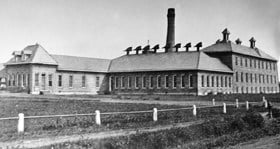 In 1881, the Allen Paper Car Wheel Co. on East North Street made railroad car wheels out of straw. This industrial location underwent many changes throughout the years, but always remained a manufacturer of paper products. In 1915, it became the Morris Paper Mill which ceased operations in 1956. Then, it became the Federal Paperboard which closed in 1980.
In 1881, the Allen Paper Car Wheel Co. on East North Street made railroad car wheels out of straw. This industrial location underwent many changes throughout the years, but always remained a manufacturer of paper products. In 1915, it became the Morris Paper Mill which ceased operations in 1956. Then, it became the Federal Paperboard which closed in 1980.
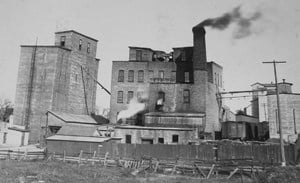 The Morris Oatmeal Co. was started in 1901 by W.G. Norton and Conrad Elerding. They built it on the north side of the railroad between Wauponsee and Lisbon Street. Later, Quaker Oats Co. bought the company and shipped their product all of the world with “Morris, Illinois” on the box. By 1921, operations had ceased.
The Morris Oatmeal Co. was started in 1901 by W.G. Norton and Conrad Elerding. They built it on the north side of the railroad between Wauponsee and Lisbon Street. Later, Quaker Oats Co. bought the company and shipped their product all of the world with “Morris, Illinois” on the box. By 1921, operations had ceased.
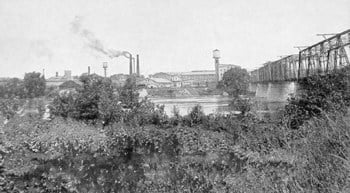
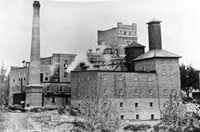


RECREATION

A view looking north on Liberty Street in 1880. The light colored building in the center is Hopkins House where Lincoln was shaved in the basement by “Wash” Foster, a freed African American, in 1858. Next to it is the Baum’s building.
Henry Baum established Baum’s Dry Goods in Morris in 1874 and settled in its present location on Liberty Street in 1888. A Conservatory of Music was held upstairs for instrumental and voice lessons in the late 1800’s.
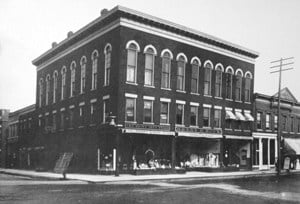
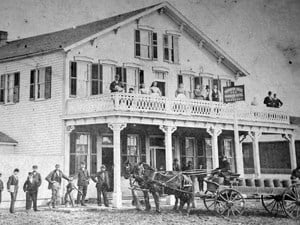
The Washington House on Main Street was built in 1867 – with additions to the west in 1875 and 1877. It was one of many hotels offered in the booming town. It had stables and a courtyard in the center to accommodate the guest’s horses. Two other hotels, Clifton House and Commercial Hotel, offered mud baths to their guests.
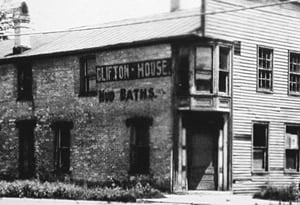
With prosperity and wealth, fishing and hunting soon became a pastime rather than a necessity. A horse-racing park between Armstrong Street and Ashley Road was built in 1891. Square dances, box socials, “catching the greased pig” contests, spelling bees, and carnivals were common occurrences as the town grew in size. In the early 1900’s, the “Morris Reds” baseball team (left) played in a stadium that once stood on the east end of North Street, near the old Paper Mill.
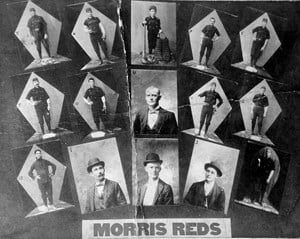
The first Grundy County Corn Festival was September 24 – October 4, 1948 sponsored by the Morris Business Men’s Association. A farmer named John Gallagher won $10 and was crowned “King” when he submitted the longest ear of corn measuring 13 5/8 inches. On the last day of the festival, a crowd of 10,500 came to witness the lighting of the new mercury vapor street lights and walk on the newly blacktopped roads.


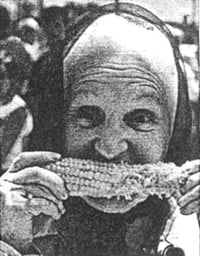
TECHNOLOGY
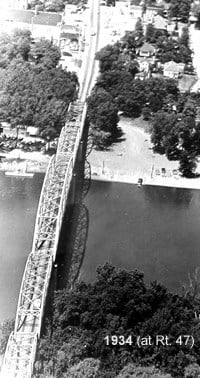
After crossing the river for many years by ferry, a wooden toll bridge was built at the end of Calhoun Street in 1856 and then replaced by steel in 1900. By 1933, barge travel had increased and a third bridge was built at the end of Division Street, much higher than the earlier bridge. It had faithfully served Morris until Fall 2002. A fourth bridge has been constructed by its side and was completed in 2004.
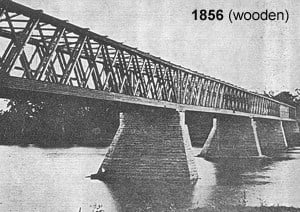
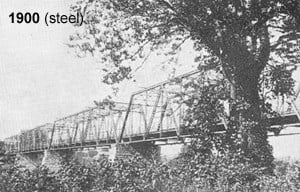
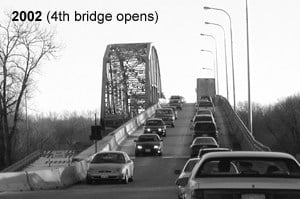
Fine quality clay found below coal veins attracted capitalists to Grundy County. The quality was considered one of the best in the U.S. The Steep & Washburn Tile Factory (above) on Quarry Street operated from 1891-1901. Jugtown, in Goose Lake Township, was a boom town of 40 potters and their families in the 1850’s.
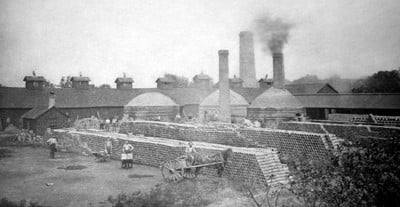
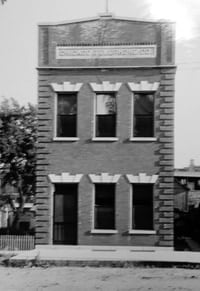
In 1883, Morris had its first telephone switchboard installed (bottom). Farmer lines often had up to 20 parties on one line – listening was called “rubbering”. In 1906, the Chicago Telephone Company building (left) was constructed behind the Baum’s building facing Main Street. It was the largest suburban telephone exchange in the nation at that time. The current building on Jefferson was constructed in 1958 with automatic operators. By the mid-1960’s every home had its own private line.
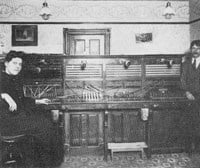
Dresden Nuclear Power Station was the first privately financed, full-scale nuclear plant in the U.S. It was put into service in 1960 and to this day furnishes energy to much of Chicago and Northern Illinois. The original “ball”, however, is not in operation.
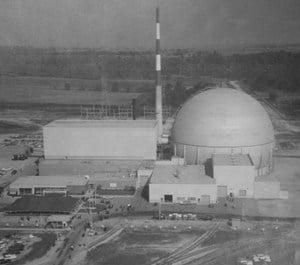
TRANSPORTATION
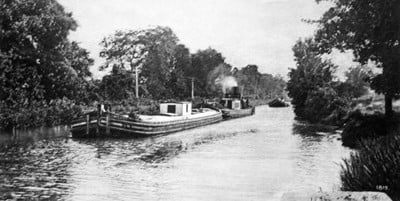
The I&M Canal was one of Morris’ greatest assets in its early growing years. Grants from the government began construction in 1836, and the 96-mile length took twelve years to complete. Beginning in Chicago and ending in LaSalle, it was the first link between the Great Lakes and the Mississippi River. Immediately, grain prices tripled in value as this became the primary mode of transportation for farmers. Five years later, the influence of the canal was replaced by the train and Morris grew to the north near the tracks. The last boat passed through in 1914.
The great bison herds were the first to cut paths known as “buffalo traces” through the tall grass of the plains. Indians followed these trails which were later used by covered wagons and stagecoach routes. Old Stage Road on the west side of Morris, built in the 1830’s, follows one of these buffalo traces. Early road construction was extremely slow due to the rich, deep topsoil. Gravel was first used in Morris to secure the muddiest areas, then bricks in 1904, and finally asphalt in 1948.
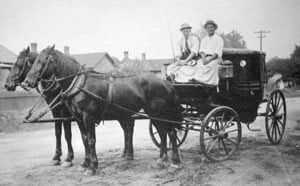

On January 5, 1853, the first steam train pulled into the depot in Morris, an event the whole town came to witness. The Chicago-Rock Island Railroad soon became the most economical transportation for coal, grain, and passengers and eventually caused the demise of the I&M Canal. Top speeds at that time were only 5 mph, and derailments happened often since the trains weren’t built with a braking system – the inventors were too concerned with making them run! The locomotives were stopped by laying huge objects, such as tree logs, in their path before the braking system was finally installed in later models.

The Chicago, Ottawa, and Peoria Electric Railway came to Morris in 1910 and a line was installed in 1913 down Liberty Street. The cost to ride in town was 5 cents. Passengers and freight could ride as far away as Chicago. State highways brought an end to the Interurban and operations ceased in 1934. The old Morris depot built in 1911 can still be seen on the southeast corner of Benton and Liberty Street.
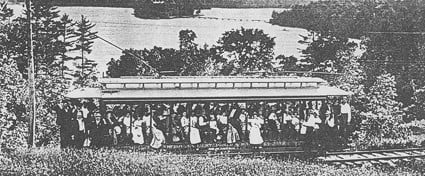
OUR FUTURE
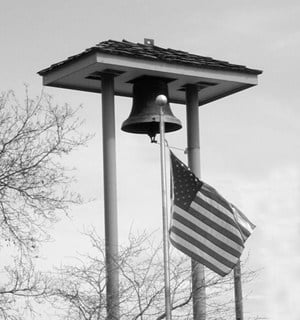
Today, our national symbol of freedom flies near the bell that once perched on top of the fire house of 1868. It is no longer used for the fire alarm, but now serves as a memorial of Morris’ loyal volunteer firefighters. The city of Morris is humbly grateful to all those who have served to defend and protect our community, including those in the police force, military, and government. Thank you to all for sacrificing your lives for our city and the United States of America. We could not have had any future without you. God bless you and thank you.
In celebration of Morris’ Sesquicentennial in 2003, the Sesquicentennial Time Capsule was buried at the Canal Port Park in February 2004. The park is located west of the Canal Port Plaza on Illinois Avenue. The Capsule, which contains photographs, drawings, essays, poems, and stories, is buried in cement at the park and marked with an engraved plaque commemorating the event.
